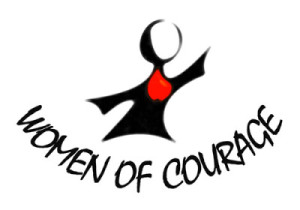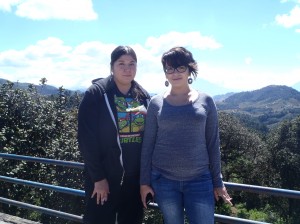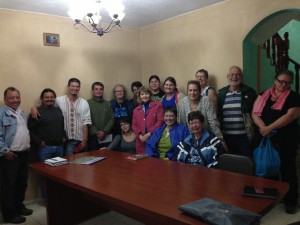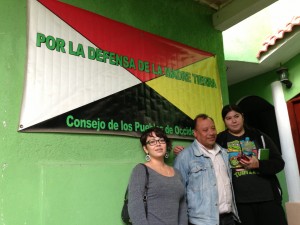The Road to San Marcos

Guest Writer, Tanis Desjarlais
Tanis Desjarlais is a Cree/Assiniboine woman from Kawacatoose First Nation in Saskatchewan. She has studied community work at George Brown College and has a strong interest in law as it relates to Indigenous peoples in Canada.
Today, we traveled from Guatemala City to Chimaltenango to meet Mr. Vidalino Similox of the Ecumenical Council of Guatemala. It was an amazing journey through the mountains. The landscape is breathtaking and we passed many small towns and communities along the way. Seeing the old people made me very curious as I am sure they carry many secrets, both beautiful and painful. I wonder if they share the joy and pain they have experienced and endured with their grandchildren. I wonder if they share stories of resistance, war, and violence, as well as positive experiences such as tales of first love and of fun times with siblings and cousins. The Indigenous people here could be my brothers and sisters. We share similar struggles and even look the same.
When we got to Chimaltenango it made me happy to hear how Mr. Similox spoke of Indigenous people. He said Indigenous people give him hope, especially the women. He said God expresses himself through the people and he sees the power of God in Indigenous resistance. He said it is very important that all churches unite in getting the Indigenous peoples’ voices heard in order to stop the destructive corporations.
I was reminded of this when we traveled to San Marcos and met with people from COPAE, the Commission on Peace and Ecology. They are very knowledgeable about the profound connection Indigenous people have to the land. COPAE has done monitoring and tests on how mining activities impact the water and the health of communities, including blood tests showing the presence of heavy metals in some people who live near the mine.
The people we have visited share similar stories about the land and how important it is to sustaining their ways of life. They said that not only do the companies affect the land, but the tactics they use to divide communities are enormously destructive because it impacts them spiritually.
I found it hopeful that the community of Sipakapa stopped a mine from being built on its land. It was so beautiful when one of the speakers at COPAE, an Indigenous man, spoke of his deep connection to the land and of how committed he is. It is so similar to the struggle Indigenous people face in Canada. I find it hurtful that some people see Indigenous people as simply being “in the way.” These people do not appear to have any respect for Indigenous peoples’ land, ways of life or for the laws they have followed for thousands of years. The speaker said that until Indigenous people are seen as equals, they will continue to resist.
It has been an unforgettable experience to hear the speakers; their stories of hope, beauty, pain and resistance inspire me to take action in my own community and, of course, to become an ally of the Indigenous people of Guatemala so that I can help them get their voices heard. It breaks my heart that so many people who are resisting are being criminalized or killed. The agenda of colonization and genocide still occurs, but Indigenous people are here and will continue to resist.






